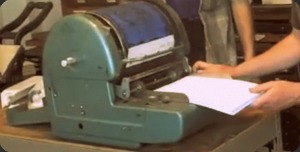

In 1891, David Gestetner patented his Automatic Cyclostyle. ( Roneograph, also Roneo machine, was another trademark used for mimeograph machines, the name being a contraction of Rotary Neostyle.) Over time, the term became generic and is now an example of a genericized trademark. Dick Company of Chicago as the owner of the name. It is currently listed as a dead entry, but shows the A.B.

0356815 for the term mimeograph in the US Patent Office. The word mimeograph was first used by Albert Blake Dick when he licensed Edison's patents in 1887. In 1880, Edison obtained a further patent, US 224,665: "Method of Preparing Autographic Stencils for Printing," which covered the making of stencils using a file plate, a grooved metal plate on which the stencil was placed which perforated the stencil when written on with a blunt metal stylus. The patent covered the electric pen, used for making the stencil, and the flatbed duplicating press. Thomas Edison received US patent 180,857 for Autographic Printing on August 8, 1876. The process was commercialized and Zuccato applied for a patent in 1895 having stencils prepared by typewriting. This sheet – which had now become a stencil – was placed on a blank sheet of paper, and ink rolled over it so that the ink oozed through the holes, creating a duplicate on the second sheet. Zuccato's system involved writing on a sheet of varnished paper with caustic ink, which ate through the varnish and paper fibers, leaving holes where the writing had been. Its earliest form was invented in 1874 by Eugenio de Zuccato, a young Italian studying law in London, who called his device the Papyrograph. Use of stencils is an ancient art, but-through chemistry, papers, and presses-techniques advanced rapidly in the late nineteenth century:Ī description of the Papyrograph method of duplication was published by David Owen: Ī major beneficiary of the invention of synthetic dyes was a document reproduction technique known as stencil duplicating. Beginning in the late 1960s and continuing into the 1970s, photocopying gradually displaced mimeographs, spirit duplicators, and hectographs.įor even smaller quantities, up to about five, a typist would use carbon paper. Early fanzines were printed by mimeograph because the machines and supplies were widely available and inexpensive.

Mimeographs, along with spirit duplicators and hectographs, were common technologies for printing small quantities of a document, as in office work, classroom materials, and church bulletins. The process is called mimeography, and a copy made by the process is a mimeograph. When an original of multiple pages is printed, each page is printed on paper from all the selected trays.A mimeograph machine (often abbreviated to mimeo, sometimes called a stencil duplicator) is a low-cost duplicating machine that works by forcing ink through a stencil onto paper. : Carbon copies are printed page by page. When an original of multiple pages is printed, all pages are printed on paper from one tray, then the next tray is used. : Carbon copies are printed in order of selected trays. Select the order of outputting carbon copies. Select the check boxes for all paper trays to be used. The paper tray for printing the original is displayed. Specify the paper tray for carbon copies and output order, and click. In in the tab, select the paper tray for printing the original. You cannot print multiple copies when using the Carbon Copy function. This function is useful when you want to create a submission document and its copy at one time. Because you can obtain printing results that look like carbon-copied slips using the print command once, this function is called Carbon Copy.įor example, by using the print command once, you can print a submission document on high-quality paper loaded in Tray 1 and print your copy on recycled paper loaded in Tray 2. You can print the original on different sheets of paper loaded in multiple trays.


 0 kommentar(er)
0 kommentar(er)
